You Won't Believe How Easy AI Blog Post Generators Make Content Creation!
AI blog generators are transforming the way we approach content creation and management. With their advanced capabilities, these tools are making it easier than ever to generate engaging blog posts without the need for extensive time and effort.
Gone are the days of spending countless hours brainstorming, writing, and editing blog posts. Thanks to AI technology, we now have access to a faster and more efficient solution. By leveraging the power of automation, you can create high-quality content in just a few clicks.
In this article, we'll explore how these blog writing tools can help with:
- Hyper-personalized blogs
- Document-aware articles
- Ads and landing pages
What are Blog Post Generators?
Blog post generators are a type of AI writing tool that use artificial intelligence to make it easier for you to create great content. These tools analyze lots of information to understand how language works and then generate written material that fits the tone, style, and topic you want. They're perfect for overcoming writer's block!But what's the secret behind their magic? Here's a simple explanation:
1. Natural Language Processing (NLP)
AI blog post generators use Natural Language Processing (NLP) techniques to understand and generate human-like text. They can analyze the structure, meaning, and context of words and sentences in a given text. Here are some key aspects of NLP in AI writing generators:
- Tokenization: The process of breaking down text into words, phrases, and sentences.
- Dependency Parsing: Analyzing the grammatical relationships between words in a sentence and understanding their roles in the overall structure.
- Coreference Resolution: Identifying when different words or phrases in a text refer to the same entity, allowing for a more coherent and consistent generation of content.
- Semantic Role Labeling: Determining the roles and relationships between words within a sentence, such as the subject, object, and verb.
- Part-of-speech tagging: Identifying the grammatical role of each word in a sentence.
- Named Entity Recognition: Detecting and categorizing named entities, such as people, places, and organizations.
- Sentiment Analysis: Determining the sentiment or emotion behind a piece of text.
2. Deep Learning
These AI blog writing tools leverage deep learning algorithms to create content that is coherent, logical, and informative. This technology helps them understand complex sentence structures and produce content that is relevant to the topic at hand. Some popular deep learning techniques used in AI writing generators include:
- Recurrent Neural Networks (RNNs): A type of neural network that can handle sequential data and learn patterns over time.
- Convolutional Neural Networks (CNNs): Primarily used for image processing, CNNs have also been adapted for natural language processing tasks due to their ability to detect patterns in data and learn hierarchical representations.
- Long Short-Term Memory (LSTM) Networks: A special kind of RNN designed to address the vanishing gradient problem, which occurs when gradients become too small to make significant updates to the network's weights. LSTM networks are particularly effective at capturing long-range dependencies and context in text.
- Bidirectional Encoder Representations from Transformers (BERT): A pre-trained model that leverages transformer architecture and bidirectional training to learn contextual representations of words in a text. BERT has demonstrated superior performance across various natural language processing tasks.
- Reinforcement Learning: Some AI writing generators employ reinforcement learning techniques to fine-tune their language generation capabilities. In reinforcement learning, an AI system learns by interacting with an environment and receiving feedback in the form of rewards or penalties.
- Policy Gradient Methods: This class of reinforcement learning algorithms learns a policy (a set of actions) by directly estimating the gradient of the expected reward with respect to the policy's parameters.
- Q-Learning: An off-policy reinforcement learning method that learns the value of taking certain actions in specific states by iteratively updating a Q-table.
- Transfer Learning: Transfer learning is a method that allows AI writing generators to leverage knowledge gained from pre-trained models and apply it to new, related tasks.
- Transformer Models: Advanced models that can capture long-range dependencies and improve the context understanding in text.
- Attention Mechanisms: Techniques to help the AI system focus on the most relevant information for generating content.
- Multi-Task Learning: An approach where blog post generators are trained to perform multiple tasks simultaneously, allowing the system to share knowledge and potentially improve its performance across different tasks.
3. Pre-trained Models
Many blog posts generators come with pre-trained models that have been fed large datasets of text from various sources. These models help the AI system generate content faster while maintaining quality. Some benefits of pre-trained models include:
- Faster training times: Since the models have already been trained on vast amounts of data, they require less time to fine-tune for specific tasks.
- Better context understanding: Pre-trained models often have a broader understanding of language, which helps in generating content with better context and relevance to the topic.
- Adaptability: These models can be fine-tuned for different domains and industries, making them versatile and applicable to a wide range of content generation tasks.
- Customizability: Pre-trained models offer a solid foundation for further customization, allowing users to tailor AI-generated content to their specific needs and preferences. This means that businesses and individuals can benefit from content that is more closely aligned with their brand voice and target audience.
- Improved accuracy: Thanks to their extensive training, pre-trained models can produce content with a higher degree of accuracy and consistency. This results in fewer errors and revisions, saving time and resources for users who rely on AI-generated content.
- Language versatility: Many pre-trained models are available for a variety of languages, enabling users to generate content in multiple languages without needing to train separate models for each. This can be particularly beneficial for businesses with an international audience or those looking to expand into new markets.
- Cost-effectiveness: Utilizing pre-trained models can help users save money on content creation. By reducing the time spent on content generation, businesses can allocate resources more efficiently and focus on other important aspects of their operations.
- Collaborative opportunities: blog post generators equipped with pre-trained models can be integrated with other tools and platforms, enhancing collaboration and streamlining the content creation process. For example, integrating AI writing tools with project management software can help automate parts of the content planning and production workflow.
How to Use A Blog Content Generator
Junia.AI is one of the best AI writers currently in the market for producing SEO-rich content. This blog post generator belongs to one of its AI-powered text generation tool offerings. Here's a step-by-step guide on how to use a blog post generator, which can significantly simplify the process of writing engaging blog posts and help you connect with your audience more effectively.
1. Enter topic and keywords of your blog post
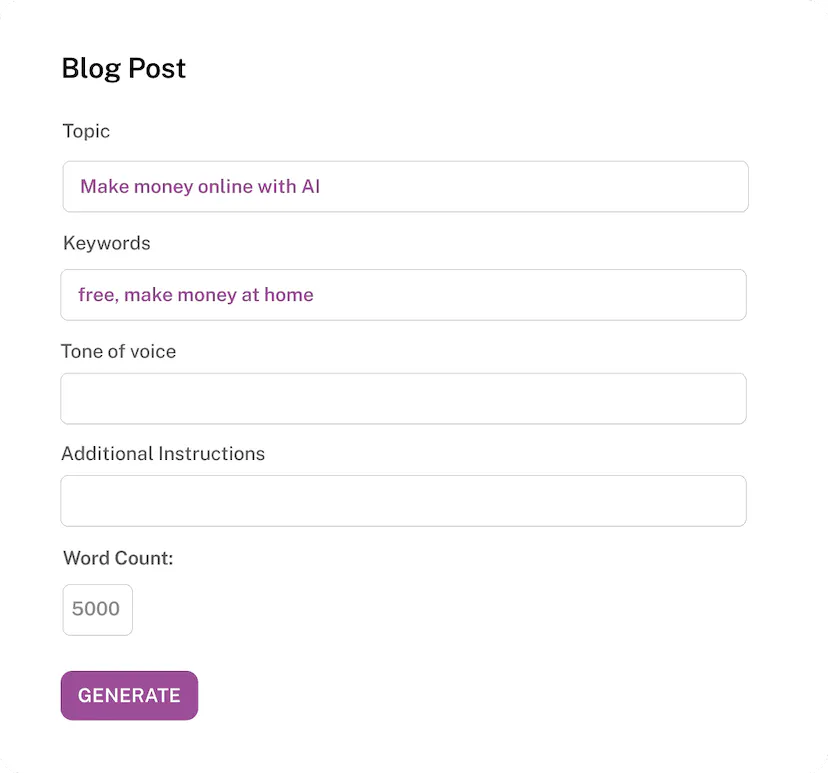
Start by providing the topic and keywords that you want your blog post to focus on. This helps the AI understand the context and generate relevant content.
2. Customize Tone of Voice and Content Output

Junia AI's Blog Generator allows you to customize the tone of voice and style of your article. You can choose from various options such as formal, casual, informative, persuasive, etc. This ensures that the generated content aligns with your brand's voice and resonates with your target audience.
3. Generate The Final Blog Post
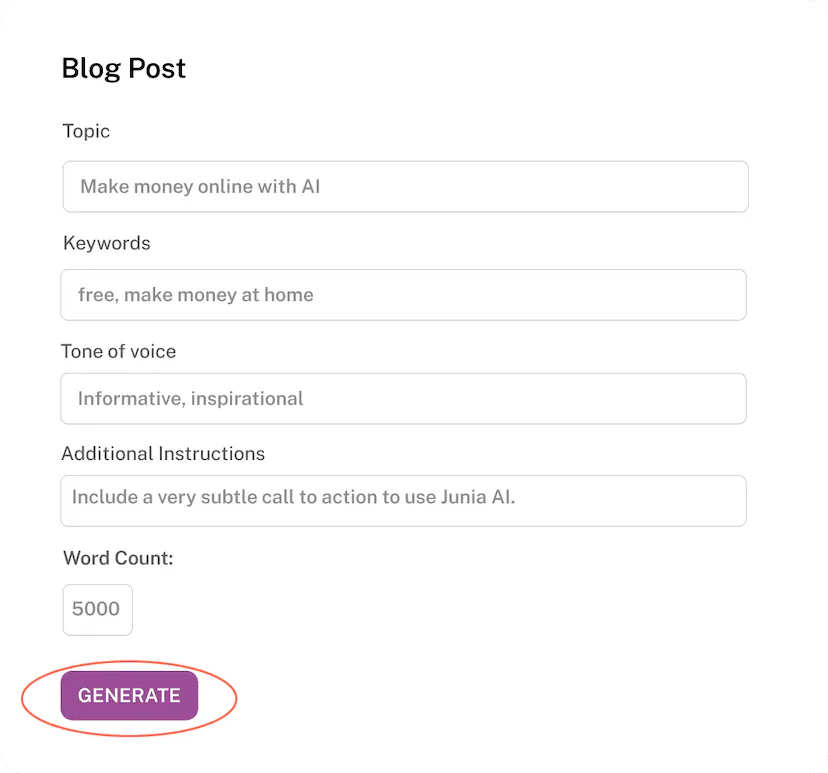
Once you've entered the necessary information and customized the settings, you can proceed to generate the final article. Junia AI's Article Generator leverages its powerful algorithms and pre-trained models to generate high-quality, well-structured content that is ready to be published.
4. Edit the Generated Blog Posts Using the AI Content Editor
.webp?token=eyJhbGciOiJIUzI1NiIsInR5cCI6IkpXVCJ9.eyJ1cmwiOiJ1c2VyLWdlbmVyYXRlZC1pbWFnZXMvZjJmOThkNWUtNjNjNC00MTJiLTkyY2QtZjgyNDI5NTE3YWRkLzFfTlM4Vm9hU0VmaGp5bGs5REZQcUVVQSAoMSkud2VicCIsImlhdCI6MTY5NjcxMjc0NCwiZXhwIjoxODU0MzkyNzQ0fQ.7c5s-WagXn2K8M66ztGHjtqma7rcwEL5QLrTBwdMukI)
After generating the blog post, you have the option to further refine and enhance it using an AI content editor. This allows you to make any necessary edits or additions to ensure that the content meets your specific requirements and reflects your unique perspective.
5. Publish the Blog Post
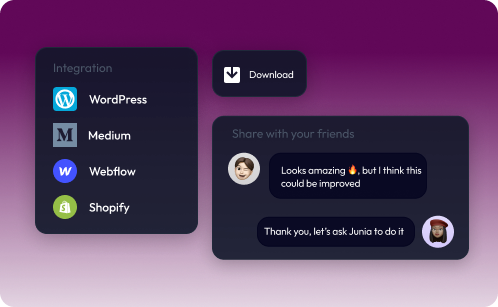
Once you are satisfied with the final version of your blog post, you can publish it directly from the Blog Post Generator to various platforms such as WordPress, Medium, Webflow and Shopify. This eliminates the need for manual copy-pasting or exporting to other publishing tools, streamlining your content creation process and saving you valuable time.
The Good Old Tough Days of Blog Writing

Before AI, writing a blog post was a lot of work. You had to come up with interesting topics that would appeal to your audience, do thorough research to gather relevant information, and then actually write the post while making sure it was free of any mistakes.
There was also the challenge of catering to an international audience. If you wanted your content to be successful globally, you had to be able to write in multiple languages.
And let's not forget about the cost. Hiring skilled writers or spending hours writing yourself could be expensive. And trying to integrate traditional writing methods with other tools or platforms for better collaboration and workflow could often be more troublesome than helpful.
But with blog generators powered by AI, all these problems are solved. They can create content effortlessly, translate it seamlessly, are cost-effective, and promote teamwork - completely revolutionizing the world of content creation.
How Can AI Blog Post Generators Help with Content Creation?
.png?token=eyJhbGciOiJIUzI1NiIsInR5cCI6IkpXVCJ9.eyJ1cmwiOiJ1c2VyLWdlbmVyYXRlZC1pbWFnZXMvZjJmOThkNWUtNjNjNC00MTJiLTkyY2QtZjgyNDI5NTE3YWRkL0dyb3VwIDExNDc2ICgxKS5wbmciLCJpYXQiOjE3MTE3OTcwNzgsImV4cCI6MjAyNzE1NzA3OH0.AV1u3sVTbrnCDkV8jAzx7Dc095uNXERX0UIiw5zRfJ4)
AI blog post generators are a game changer for content creation. These innovative tools leverage artificial intelligence to automate the writing process, generating high-quality, engaging content in a matter of seconds. Let's take a closer look at how AI blog post generators can help with content creation and explore some popular tools like paragraph generator, product description generator, and sentence rewriter.
Effortless Content Generation

Creating blog posts from scratch can be a time-consuming and mentally exhausting process, especially when you're trying to maintain a consistent posting schedule. This is where AI blog post generators come in, acting as a beacon of relief by simplifying the task at hand and allowing you to focus on refining your content and curating it to meet your audience's needs.
These handy blog writing tools offer a wide array of benefits that propel your content creation process into a new realm of efficiency:
- Generating ideas based on keywords or topic input: No more writer's block! With an AI blog post generator, all you need to do is input a few keywords or a specific topic. The AI gets to work and generates a list of unique ideas for you to choose from or even construct your entire article around. For example, if you enter 'digital marketing' as your keyword, the tool might suggest topics like 'The Future of Digital Marketing' or 'How Digital Marketing affects consumer behavior'.
- Providing suggestions for headlines, subheadings, and article structure: Crafting an attention-grabbing headline, Choosing the right subheadings and arranging your content into an interesting story can be tough without help. AI blog post generators come to the rescue by suggesting captivating headlines, relevant subheadings, and even providing an overall structure for your article to ensure maximum readability and engagement. For example, for a post about 'Healthy Eating', an AI could suggest a headline like 'The Ultimate Guide to Healthy Eating', with subheadings like 'Benefits of a Balanced Diet', 'Easy Healthy Recipes', etc.
- Crafting paragraphs that flow seamlessly: One of the most critical aspects of a great blog post is ensuring that your content flows logically and smoothly. This is not easy when writing manually. However, AI-powered tools can generate coherent paragraphs that transition seamlessly from one idea to another. This makes your article more appealing by making it easier to read and understand.
Maintain Consistent Tone of Voice
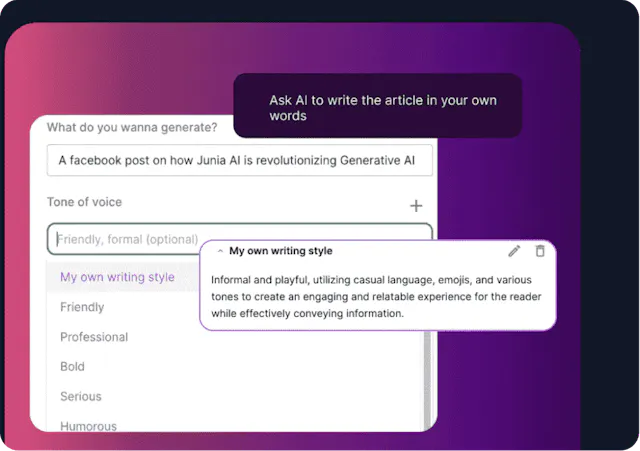
Imagine having a cool friend, like Junia, who can effortlessly mimic your style of conversation. That's what AI blog post generators are like. They're designed to learn and replicate your brand's voice, making all your content feel uniquely you. It's like having your very own ghost writer who understands and replicates your unique style flawlessly.
But how does this work? The AI carefully analyzes all your previous content – the tone of your voice, your unique style, the way you express ideas – even those small details that make your content uniquely yours. Once it understands these elements, it uses that information to generate new content that imitates your writing style. What's even better is that this consistency in voice and tone is maintained across all platforms – whether it's blogs, articles, newsletters, or social media posts.
This AI-powered blog generator is like a reliable ally, always there to assist you. Just give it keywords and a topic, and it quickly creates new blog posts. For instance, if you have a health blog and need a series on 'Healthy Eating,' the AI can generate articles like 'The Ultimate Guide to Healthy Eating,' 'Benefits of a Balanced Diet,' etc., all in your style. It's like having an untiring writer who constantly comes up with creative ideas while keeping your brand's unique voice in every piece of content.
Using blog post generators can significantly simplify the lives of writers. These tools speed up the process of creating content and improve the overall quality of output. As a result, writers can dedicate more time to polishing their work instead of starting from square one. Just imagine being able to generate numerous high-quality articles, for instance, with the assistance of a bulk content generator in a fraction of the time it would normally take. This is the power of AI in content creation.
Paragraph Generator
A Paragraph Generator is an AI-driven writing tool designed to make a writer's life easier by generating coherent, well-structured paragraphs on any given topic. These innovative tools create custom content that aligns with the target audience’s preferences and interests, enhancing reader engagement. Here's a closer look at how these impressive generators operate:
How does a Paragraph Generator work?

- Input your desired topic or keywords: Start by feeding the generator with the topic or keywords you'd like your paragraph to encompass. This critical first step allows the AI to understand the context, enabling it to craft a paragraph that's relevant and engaging.
- Select the tone of voice or writing style: After defining your content's scope, choose the tone of voice or writing style for your paragraph. Whether you're aiming for a formal or casual, informative or persuasive tone, the generator can adjust to fit your needs.
- Click generate: With your specifications set, hit the 'generate' button and watch as the tool transforms your inputs into a well-crafted paragraph.
In just moments, you'll have a unique paragraph that fits seamlessly into your article, resonating with your readers and enhancing overall readability.
Product Description Generator: An Indispensable Tool for E-commerce
In the competitive world of e-commerce, engaging and compelling product descriptions can be the difference between making a sale or losing a potential customer. These descriptions serve as your digital salesperson, providing crucial information that influences consumer purchasing decisions. To help with this crucial task, a product description generator can be an invaluable resource.
This cutting-edge tool uses Artificial Intelligence (AI) to create detailed and persuasive descriptions that effectively communicate the unique features and advantages of your products. These descriptions are designed to:
- Capture your audience's attention
- Paint a vivid picture of what you're selling
- Ultimately drive conversions
Here's an example of how a product description generator can transform a generic description into something more enticing:
Instead of writing something generic like "High-quality portable Bluetooth speaker with great sound", a product description generator might produce something like "Experience music like never before with our Portable Bluetooth Speaker. With its high-definition sound quality, seamless Bluetooth connectivity, and compact design, you can enjoy your favorite tunes wherever you go."
Using a product description generator is simple and straightforward:
- Start by providing the product name along with its key features and unique benefits. For instance, if you're selling a 'Wireless Charging Pad', list features like 'Fast-Charging', 'Universal Compatibility', 'Sleek Design' etc.
- Choose your preferred writing style to ensure the generated description aligns with your brand's voice. Whether you want a casual tone for lifestyle products or a formal one for professional equipment, the choice is yours.
- Click on the 'generate' button to create an enticing product description tailored specifically to your product.
In just a few easy steps, you'll have a powerful product description ready to attract and impress potential customers! By saving you time and effort, this tool lets you focus on other important aspects of your e-commerce business.
Sentence Rewriter
Maintaining originality while ensuring readability and engagement can be a challenging task when creating blog posts. But what if you could refresh your content without losing its original essence? That's where a sentence rewriter tool comes in. By intelligently rephrasing sentences, it helps to enhance the overall quality of your content without distorting their original meaning.
To understand how to use a sentence rewriter effectively, follow these steps:
- Enter the Original Sentence: Start by inputting the sentence you wish to rewrite into the tool. It can be anything from a technical explanation to a funny story - it's up to you!
- Click on 'Generate': Once you've entered your sentence, click on 'generate'. The tool will then use advanced AI algorithms to create different versions of your sentence, each with its own style and tone.
- Choose Your Preferred Variation: After generating multiple options, choose the one that best suits your article in terms of context and style. You might go for a version that simplifies complex words or one that adds some humor - it depends on what your content needs!
By following these three simple steps, you'll have a better sentence that not only brings something new to your content but also makes it easier to read and more engaging.
But a blog post generator's abilities in content creation go beyond just rewriting sentences. As we've seen earlier, AI-powered blog post generators are completely changing the content creation process. We can take it a step further by incorporating tools such as paragraph generators and product description generators into our work routine. This allows us to effortlessly create captivating and top-notch articles.
For instance, imagine you're launching a new line of skincare products. A product description generator can help you craft compelling descriptions that highlight key features like 'Organic Ingredients', 'Dermatologist-Tested', or 'Suitable for All Skin Types'. Similarly, a paragraph generator can come in handy when writing detailed product reviews or informative blog posts about skincare routines.
Hyper-Personalized Blogs: The Future of Content Creation
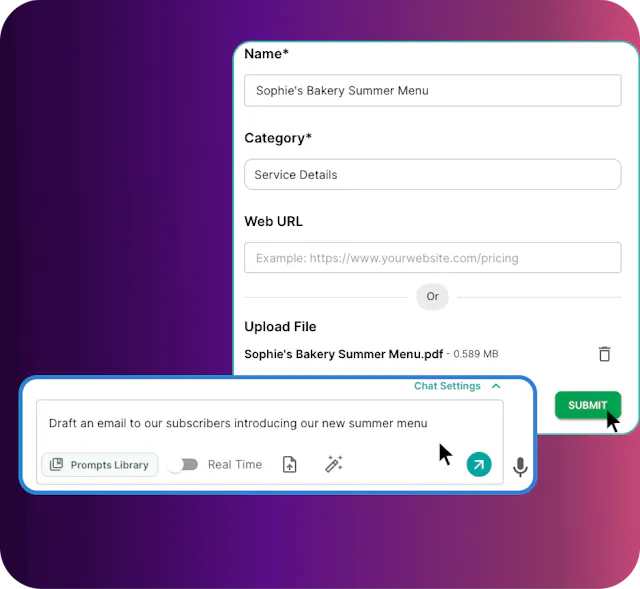
Hyper-personalized blogs are the next big thing in content creation. These blogs are tailored to individual readers, providing them a unique, engaging, and highly relevant experience. By using AI and SEO-optimized blogs, hyper-personalization becomes more achievable than ever before.
AI and Hyper-Personalized Blogs
Artificial Intelligence (AI) can analyze a vast volume of data from user behavior, preferences, and demographics to create comprehensive profiles. This knowledge empowers content creators to craft blog posts that deeply resonate with their target audience.
How AI Enhances Blog Personalization
Here are some ways in which AI can enhance blog personalization:
- Social Media Activity: Analyzing users' likes, shares, and follows on various social media platforms provides valuable insight into topics and content styles that resonate with them. For instance, if a user frequently likes and shares articles about sustainable fashion on Facebook or Instagram, AI can infer that they're interested in this subject. Consequently, blog posts related to sustainable fashion practices, brands, or trends could be recommended or created for this user.
- Past Behavior on Your Blog: By evaluating which articles a reader has engaged with before on your blog, AI can detect patterns and suggest similar content. For example, if a reader consistently reads and comments on articles about vegan recipes on your blog, AI tools can identify this pattern. It could then recommend other vegan-related articles to them or even generate new ones focusing on unique vegan recipes or diet tips.
- Demographics and Interests: Combining demographic information (like age, location, gender) with expressed interests helps generate more accurate reader profiles. If an 18-year-old female from New York shows interest in Korean skincare routines through her search history and social media activity, AI can tailor skincare-related content towards her preference. This may include Korean skincare product reviews or step-by-step guides for implementing these routines.
Generating Tailored Content
With AI, you can create multiple versions of a blog post for different target audiences based on their interests and preferences, making sure that everyone finds it interesting and relevant. By using AI-powered writing tools like blog posts generators, you can enter a new era of personalized content creation.
- Create Variations of Your Blog Post: Generate alternative headlines, introductions, and even entire paragraphs to cater to specific audience segments. For example, if your blog post is about "How to Stay Fit," you can create different versions targeting various demographics: one version for busy professionals highlighting quick workout routines, another for parents emphasizing family-friendly fitness activities, and yet another for seniors focusing on low-impact exercises. This way, the same core content can be tailored in a way that resonates with each reader group.
- Curate Personalized Content: AI can suggest relevant articles, videos, and other content from your blog based on a reader's preferences. Let's say a reader has shown interest in vegan recipes on your blog; AI tools can identify this pattern. They might then recommend other vegan-related articles or suggest videos demonstrating vegan cooking techniques from your blog. This not only keeps the reader engaged but also enhances their overall experience by providing them with more of what they love.
Additionally, AI can also help:
- Adapt Content Based On User Behavior: AI can analyze readers' behavior including how much time they spend on certain topics or posts, the links they click on within the articles and their comments or likes. This information helps in generating more engaging and relatable content. For instance, if a majority of readers spend more time on posts about eco-friendly lifestyle tips, you could create more detailed articles or infographics on that topic.
- Enhance Content with Visuals: AI writing tools can also suggest suitable visuals - images or videos - to complement your written content. If you're writing about DIY home decor, AI might propose including step-by-step video tutorials or well-shot photographs showcasing each step for a better understanding.
By leveraging these capabilities of AI, bloggers can create deeply personalized and engaging content that resonates with their readers' unique preferences and behaviors.
Automating SEO Optimization
.webp?token=eyJhbGciOiJIUzI1NiIsInR5cCI6IkpXVCJ9.eyJ1cmwiOiJ1c2VyLWdlbmVyYXRlZC1pbWFnZXMvZjJmOThkNWUtNjNjNC00MTJiLTkyY2QtZjgyNDI5NTE3YWRkL3Nlby1tZXRhZGF0YSAoNCkud2VicCIsImlhdCI6MTcxMTc5ODYzMiwiZXhwIjoyMDI3MTU4NjMyfQ.pmaZl59k-7WjlwiS1yFhYDorXuZjBD-wd_SiH47MuOA)
By using AI, you can automatically optimize your blog posts for search engines, making them more visible to your specific target audience. This automation ensures that people who are actively searching for topics they're interested in can easily find your content.
- Keyword Research: One of the crucial aspects of SEO is keyword research, which is the practice of identifying common words or phrases that people enter into search engines. AI technology can quickly analyze vast amounts of data related to search volume and competition for various keywords. This helps in selecting the most relevant and impactful keywords for your content, ensuring that it reaches the right audience at the right time.
- On-page Optimization: On-page optimization involves optimizing different parts of your website that affect your search engine rankings. It includes elements like meta descriptions, headers, and images. AI can streamline this entire process with precision and efficiency. For instance, AI-powered tools can craft compelling meta descriptions that summarize your blog posts succinctly while incorporating relevant keywords. Similarly, these tools can assist in optimizing headers by suggesting improvements or including keywords organically. When it comes to images, AI can help by generating alt text using image recognition technology.
- Link Building: Link building is a key component of SEO strategy that involves acquiring hyperlinks from other websites to your own. These links signal to search engines that your content is valuable and credible, thereby improving your blog's domain authority - a measure of a site's credibility and relevance in Google's eyes. AI can identify potential link-building opportunities by analyzing factors like domain authority, relevance, and traffic of other websites. Additionally, it can suggest effective outreach strategies for acquiring these links.
By integrating these capabilities into your blogging strategy, you not only enhance the visibility of your content but also create a more personalized experience for your readers leading to higher engagement rates.
Exploring the Potential of AI-Driven Hyper-Personalized Blogs
Harness the power of artificial intelligence (AI) to create a blogging experience that is carefully customized to your audience's specific needs and preferences. Here are some examples of how AI can be used to create highly personalized blogs:
Fitness Blog: Custom Workouts and Nutritional Plans

Imagine a fitness blog where the content is not only informative but also interactive. The blog hosts an AI-powered tool that generates customized workout routines and nutritional plans for its readers, taking into consideration their personal preferences and requirements. Here's how it works in detail:
- Age Consideration: The AI tool considers the age of the reader while curating workout plans. For instance, the exercise routine for someone in their 20s might focus on strength building and stamina enhancement, while for a reader in their 60s, the program may concentrate on flexibility and balance. Similarly, the suggested dietary plan would take into account the changing nutritional needs with age.
- Gender-Specific Guidance: Recognizing the different physiological needs of men and women, the AI comes up with gender-specific workouts and meal plans. For example, women might get suggested certain exercises focusing on bone health considering their higher susceptibility to osteoporosis.
- Aiming at Fitness Goals: Whether the reader aims to lose weight, build muscle, increase endurance or maintain their current physique - all these factors are taken into account by the AI tool. It tailors programs accordingly, making sure that every reader gets a plan fitting perfectly with their fitness aspirations.
- Accounting for Dietary Restrictions: People have varied dietary habits and restrictions - veganism, gluten intolerance, lactose intolerance etc. Some may have allergies to specific food items as well. Catering to these specific requirements, personalized meal plans are created to ensure readers receive the right nutrition without compromising their health.
This level of personalization transforms the blog from a simple information source into an invaluable resource for health and wellness information. Readers no longer need to hop from one site to another seeking advice tailored to their needs; everything they need is available in one place. This not only encourages sustained reader engagement but also builds a loyal community around your blog who value and trust your content deeply.
Travel Blog: Bespoke Itineraries and Recommendations

A travel blog could leverage the power of AI to offer customized itineraries and destination recommendations meticulously tailored to a reader's specific preferences and requirements. These personal suggestions could be crafted based on several key factors:
- Travel History: The AI could analyze the past destinations visited by the reader through their interaction with previous content about those places. For instance, if a reader has shown a preference for tropical locations, the AI could recommend similar destinations they haven't visited yet.
- Budget: The AI can consider the reader's budget, which can be inferred from their interaction with low-cost or luxury travel content. This would ensure that the recommended destinations and itineraries stay within their financial comfort zone, thereby making the recommendations practical and achievable.
- Interests: Whether the reader is an art enthusiast, a foodie, an adventure seeker, or a history buff, AI can track their content interactions to discern their interests. This would allow for the creation of bespoke itineraries that cater to these specific interests. For example, a food lover may get recommendations featuring culinary tours or food festivals around the world.
- Time Constraints: Not everyone has the luxury of extended vacation time. The AI could suggest itineraries based on the reader's available time for travel - be it long weekend getaways or in-depth two-week explorations.
By providing such a hyper-personalized experience, the travel blog evolves from being just another source of generic information to an indispensable tool for readers planning their next adventure. Readers are presented with highly curated travel plans that align perfectly with their preferences and constraints, saving them countless hours of research and planning. This level of personalization not only enhances user engagement but also fosters loyalty as readers begin to appreciate and rely on the blog's unique value proposition.
Tech Blog: Device-Specific Content and Reviews
Imagine this: you're a huge Apple fan and you log into your favorite tech blog. Wouldn't it be cool if the blog already knew about your love for all things Apple and showed you content specially curated for you? That's the kind of magic AI can bring to the table. You'd get updates about the latest iPhones, tips and tricks for macOS, and in-depth reviews of the newest iPad - all without having to wade through stuff that doesn't interest you.
Now imagine you prefer using an Android device. In that case, the AI-powered blog can still cater to your interests by providing articles on various Android brands such as Samsung, Google Pixel, OnePlus, or any other brand you're interested in. This way, you can discover fresh ideas for using your Android devices more effectively or dive into comprehensive reviews of upcoming smartphones. Additionally, if you're considering an upgrade, the blog can offer convenient comparisons between different Android models to assist you in making a well-informed choice.
It doesn't stop there though. If you're into smart home devices, drones, wearables, or any other type of gadgetry, AI could tailor content based on those interests too. The latest product releases, trends in the industry, expert reviews - everything neatly packed in one place.
With AI on board, blogs can take personalization to a whole new level. It's not just about making online content consumption more engaging but also making it deeply satisfying by ensuring every piece of content strikes a chord with the reader at a personal level.
Document-Aware Articles: The Next Level of AI Blog Post Generation
Document-aware articles are the latest innovation in AI-generated content. Unlike traditional AI-generated content, these articles are not only SEO-optimized but also show a deep understanding of the context and structure of the entire document. This means they can create content that is more relevant, engaging, and flows naturally from one section to another.
Traditional AI-generated content may produce text that seems disjointed or unconnected. However, document-aware articles enhance the quality by ensuring that each section relates to the previous one while maintaining a coherent structure throughout the entire piece.
Here are some key differences between traditional AI-generated content and document-aware articles:
- Contextual awareness: Unlike traditional AI-generated articles that treat each section as an independent entity, document-aware articles have a holistic understanding of the entire document. They ensure that each section is seamlessly connected to the one before it, thus preventing any abrupt transitions in topics or ideas. For example, if a blog post discusses different types of vegetarian diets in the first section, a document-aware article would intelligently contextualize subsequent sections according to this topic, perhaps discussing the benefits or potential drawbacks of these diets.
- Better flow: Document-aware articles do not just spit out information; they offer a natural flow of information. They do not rely on transitional words or phrases; instead, they understand the essence of the document and accordingly structure the text. To illustrate, in a guide about 'How to bake a cake', a document-aware article won't randomly jump from 'Gathering ingredients' to 'Final garnishing'. It will give appropriate weightage to all necessary intermediate steps like 'Mixing ingredients', 'Baking process', 'Cooling and unmolding' ensuring a logical progression.
- Improved readability: The improved structure and seamless connections make document-aware articles easier to read and understand. This is not merely about grammatical correctness or vocabulary usage, but about creating a meaningful narrative that readers can follow easily. For instance, in an article on global warming, a document-aware article would effectively connect causes, effects, and mitigation strategies instead of presenting them as isolated points. This leads to an overall improved user experience as readers are able to grasp complex concepts with less effort due to the coherent presentation of ideas.
To further illustrate the advantages of document-aware articles, let's delve into some detailed examples:
An article on healthy eating habits

Imagine you're reading an article about healthy eating. An old-school AI might give you bits and pieces about wholesome foods, workout routines, and sleep habits. But it might not link these topics together too well, leaving you flipping between different ideas.
Now picture a smarter article that gets it. It knows that chatting about nutritious food leads naturally to talking about meal planning and portion control. It could dish up details on how various food groups make up a balanced diet, and highlight just how key portion sizes are for tip-top health.
Then it smoothly switches gears to exercise routines, explaining how good nutrition powers your physical activity. It could share cool info on how different exercises need different kinds of nutrition.
And to top it off, the chat could move onto sleep patterns, underlining their huge role in recovery and your overall well-being. It might even drop in some tips on how solid nutrition and regular exercise can boost your sleep quality.
An article on digital marketing strategies
When it comes to discussing digital marketing strategies, a typical AI-generated piece might mention email marketing, social media campaigns, and search engine optimization (SEO). However, it may not fully explain how these elements work together to create an effective digital marketing strategy.
On the other hand, an informed article would seamlessly integrate these topics. It could start by exploring the importance of email marketing in retaining existing customers - delving into concepts like personalized emails or automated responses.
Next, it could discuss how social media campaigns can attract new audiences and increase brand visibility. This section could include examples of successful campaign strategies from well-known brands to provide a clearer understanding.
Simultaneously, the article could highlight the role of SEO in ensuring that your brand's website ranks high in search engine results, driving organic traffic. In this part, the fundamentals of key SEO tactics like optimizing keywords and building backlinks could be explained for beginners.
It's evident why informed articles are superior: they make reading enjoyable by presenting content that is both interesting and informative. Tools powered by AI such as Junia AI's free blog post generator can assist you in creating informed articles that elevate your content quality and distinguish it from competitors. Additionally, informed articles help establish trust and credibility with your target audience as they demonstrate your brand's deep understanding of industry complexities and their interconnectedness.
AI Blog Post Generators for Ads and Landing Pages
AI blog post generators are not limited to creating blog content. They can also generate engaging ads and effective landing pages!
Crafting Facebook Ads and Google Ad Copy with AI Generators
Creating engaging ad content requires a significant amount of time. AI blog post generators can create attractive and effective ads with just a few clicks.
These advanced AI writing tools work by taking specific keywords inputted by the user to generate tailor-made ad copy. Whether you're looking to create compelling Facebook ads or optimize your Google Ad copy, AI generators have got you covered.
- Facebook Ads: With AI-generated headlines and descriptions, creating Facebook ads has never been easier. These tools can craft engaging content that grabs your target audience's attention and encourages them to click on your ad. For instance, if your business sells eco-friendly products, the AI might generate a headline like "Go Green with Our Eco-Friendly Products" or a description like "Join our mission for a sustainable future with our range of eco-friendly products". This not only captures attention but also highlights the benefits of your product.
- Google Ad Copy: When it comes to Google ad copy, aligning your content with search intent is crucial for achieving higher click-through rates. AI generators can help fine-tune this process by producing ad text that matches what users are searching for on Google. For example, if you're a local bakery, the AI might generate ad copy like "Freshly Baked Goods in [Your City] - Order Now!"
The power of AI blog post generators extends beyond just saving time; they also help save money and effort that would otherwise be spent on drafting and tweaking ad content manually. Utilizing these tools allows businesses to focus their energy on other important aspects of their operations, while still ensuring their ads are as effective as possible.
Designing High-Converting Landing Pages with AI
Landing pages play a crucial role in every digital marketing campaign. They are the first point of contact between potential customers and your brand when they click on your ad. That's why it's essential to have well-designed and compelling landing pages! AI blog post generators can be incredibly helpful in creating these high-quality landing pages
1. Generate Captivating Headlines:
AI-powered tools can craft headlines that not only capture attention but also highlight the unique benefits of your product or service. For example, an AI could generate a headline like "Experience Unmatched Comfort with Our Ergonomic Chairs!" for a furniture company.
2. Create Engaging Subheadings:
Subheadings guide visitors through the content in an organized manner and keep them engaged. AI can create interesting and persuasive subheadings that align with the main message and keep readers interested. For instance, for a skincare brand, it might generate subheadings like "Revitalize Your Skin with Natural Ingredients."
3. Produce Compelling Call-to-Actions (CTAs):
The strength of your CTA can directly impact conversion rates. AI can produce engaging CTAs that motivate users to take the desired action. A compelling CTA for an online course might read, "Start Learning Now and Transform Your Career!"
Benefits of Using AI Blog Post Generators for Ads and Landing Pages
By incorporating AI blog post generators in the creation of ads and landing pages, businesses can reap a plethora of advantages:
- Efficiency: The use of AI significantly accelerates the copywriting process. It is capable of generating ad copy or landing page content in mere seconds. For instance, crafting a perfect ad copy for a new product launch can be time-consuming. However, with AI, you can generate engaging and persuasive copies swiftly, thereby streamlining your marketing processes.
- Consistency: With AI, you can maintain a consistent tone and voice across all your marketing materials. This consistency is crucial in building brand identity and fostering trust among your audience. For example, an e-commerce company dealing in eco-friendly products would want to maintain a conversational and informative tone that aligns with their brand values across all platforms.
- Testing: AI blog post generators allow you to effortlessly create multiple versions of ad copy or landing page content for A/B testing. This makes it easier to identify what resonates best with your target audience and optimize accordingly. For instance, you could test different CTAs like "Buy Now" versus "Add to Cart" to see which generates more conversions.
- Flexibility: You can customize the generated content to fit your specific needs and objectives. Whether you need catchy headlines for your blog posts or compelling descriptions for your products, AI blog post generators offer the flexibility you need.
- Cost-effectiveness: By leveraging AI for content creation, you can save on hiring copywriters or investing countless hours into crafting marketing content yourself. This not only reduces costs but also allows you to focus on other key aspects of your business.
AI blog post generators are indeed transforming the way we create ads and landing pages! They offer efficiency, consistency, flexibility, and cost-effectiveness – all while producing high-quality content that resonates with your target audience.
Harnessing the Power of AI in Generating Blog Content
AI blog post generators have revolutionized the way we create content, making it faster, smarter, and more efficient. These powerful AI blog writing tools enable us to:
- Generate hyper-personalized blogs
- Create document-aware articles
- Produce ads and landing pages
And so much more! With AI writing templates at our disposal, crafting the perfect piece is no longer a distant dream.
"The pen is mightier than the sword, and AI is the mightiest of them all."
Thanks to AI blog post generators, we've entered a new era of content creation where writer's block is a thing of the past. Wave goodbye to countless hours spent staring at a blank screen and say hello to instant inspiration.
Enhancing this further is Junia AI's blog post generator. It guarantees a perfect blog every single time. Just like magic, your content will materialize before your very eyes, leaving you free to focus on what matters most - engaging with your audience and growing your business.
To sum it all up:
- AI blog post generators are game-changers for content creators.
- They provide a multitude of benefits across various platforms.
- Junia AI's blog post generator is an invaluable tool for achieving content perfection.